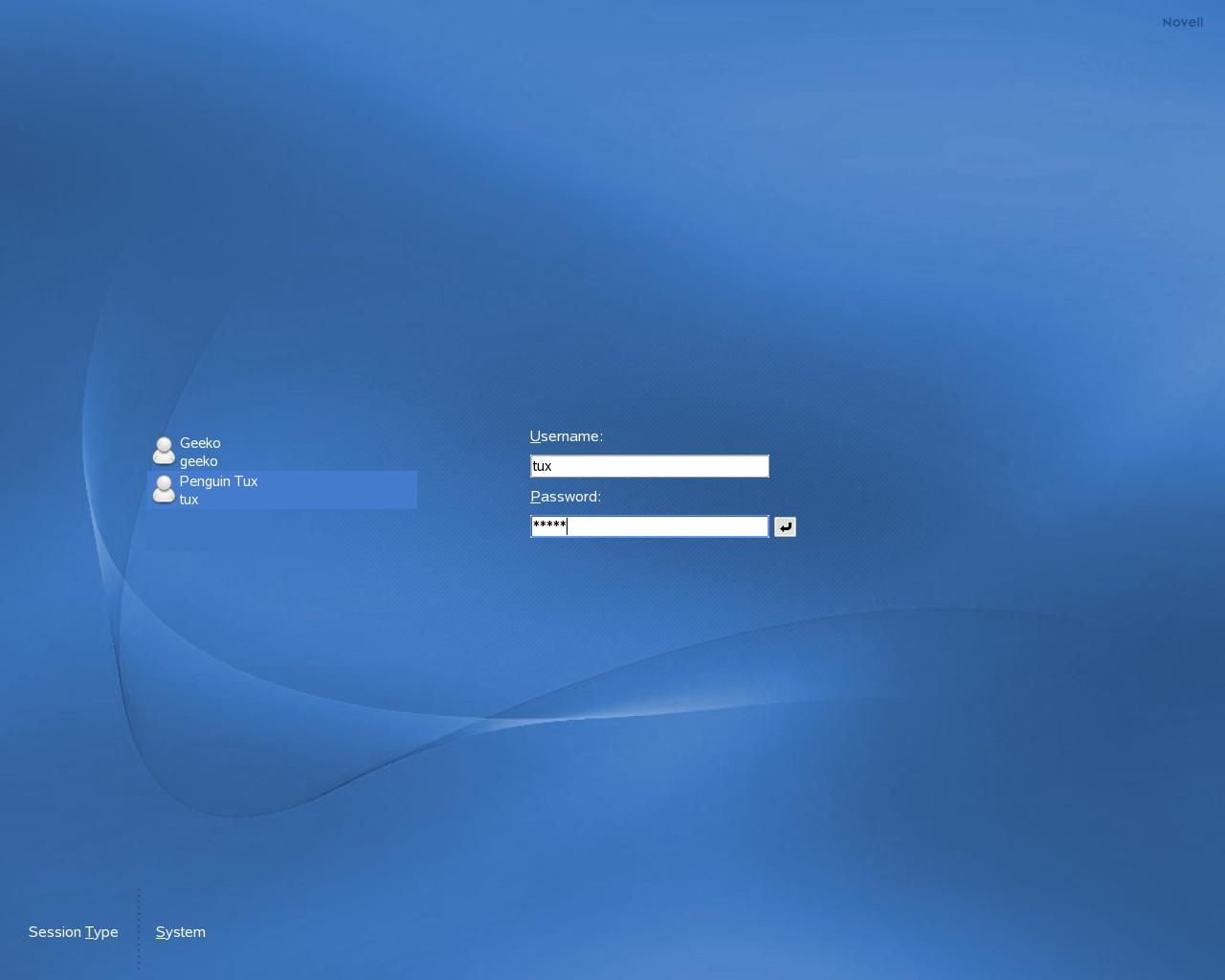1.1 Logging In and Selecting a Desktop
If more than one user account is configured on your computer, usually
all users must authenticate—unless Auto Login
is configured for a certain user. Auto login logs the user in to the desktop
environment automatically on boot. Enable or disable this feature during
installation or at any time using the
YaST user management module. For more information, see Section 5.1, Managing User Accounts,
(↑ Start-Up ). But if your computer is run in a network
environment and you are not the only person using the machine, you are
usually prompted to enter your username and password when you start your
system. If you did not set up your system and your user account yourself,
check with your system administrator for your username and password.
The program managing the login process depends on the desktop environment installed on your system. For KDE, it is KDM. If the GNOME desktop is additionally installed on your system, it may be GDM.
As shown in Figure 1-1, the default KDM login screen provides input fields for username and password and the following menu items:
-
Specifies the desktop to run when you log in. If desktops other than KDE are installed, they appear in the list. Make changes only if you want to use a session type other than your default (usually KDE). Future sessions are automatically of the same type unless you change the session type manually.
-
Performs a system action, such as shutting down the computer or starting different login actions. enables you to log in on a remote machine.
To start a normal login, just enter your username and password.
Figure 1-1 A KDM Login Screen

NOTE: Connecting to an Active Directory Server
To access shared network resources, you can also authenticate a KDE client machine against an Active Directory server. For further details, refer to Section 8.0, Accessing Network Resources. If your machine is configured for this kind of authentication, the login screen also provides an additional field. In this case, proceed as follows during login:
-
Select the domain from the list.
-
Enter your Windows* username.
-
Enter your Windows password and press Enter.
1.1.1 Controlling a Session
The Session Manager starts after your username and password are authenticated by the login process. The Session Manager lets you save certain settings for each session. It also lets you save the state of your most recent session and return to that state the next time you log in.
The Session Manager can save and restore the following settings:
-
Appearance and behavior settings, such as fonts, colors, and mouse settings.
-
Applications that you were running, such as a file manager or OpenOffice.org.
NOTE: Saving and Restoring Applications
You cannot save and restore applications that Session Manager does not manage. For example, if you start the vi editor from the command line in a terminal window, Session Manager cannot restore your editing session.
For information about configuring session preferences, see Adjusting the Session Handling.
1.1.2 Switching Desktops
If you installed both the KDE and the GNOME desktops, use the following instructions to switch desktops.
-
If you are logged in to KDE, select from the main menu. On the following login screen, click .
-
Select the GNOME desktop.
-
Enter your username.
-
Enter your password. The GNOME desktop is started.
See GNOME User Guide at http://www.novell.com/documentation/opensuse103/ for more information about using the GNOME desktop.
-
To switch back to KDE again, click on the panel of the GNOME desktop then click . The session is closed and the login screen reappears.
-
Before logging in again, click and select in the login screen. If you do not select a new session type, your next session will be of the same type (GNOME) as the session before.
1.1.3 Locking Your Screen
To lock the screen, do either of the following:
-
From the main menu, select .
-
Use the keyboard shortcut defined in the KDE control center. Usually, this is Ctrl+Alt+L.
HINT: Looking Up KDE Keyboard Shortcuts
If you are interested in other KDE keyboard shortcuts, look them up in the KDE control center, described in Section 2.0, Customizing Your Settings. For a description of how to change KDE keyboard shortcuts, refer to Modifying KDE Keyboard Shortcuts.
-
Click the icon in the panel.
When you lock your screen, the screen saver starts. To unlock the screen, move your mouse to display the locked screen dialog. Enter your username and password then press Enter.
For information about configuring your screen saver, see Configuring the Screen Saver.